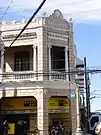Calle Real, Iloilo
Calle Real (Royal Street in Spanish), officially named as J.M. Basa Street, is a historic street located in the old downtown district Iloilo City Proper of Iloilo City, Philippines.The street often referred to as the "Escolta of Iloilo".[1] It is home to several fine examples of historic luxury American era neoclassical, beaux-arts, and art deco buildings. The street has been famous since the Spanish Era. However, its importance has dwindled and the street has become less maintained; yet there have been efforts to revitalize the street, which include the restoration of the historic buildings along the street and beautification projects.
| J.M. Basa Street (official) | |
.jpg.webp) Pedestrianized Calle Real during the Dinagyang Festival | |
| Former name(s) | Calle Real |
|---|---|
| Namesake | Jose Maria Basa (official name) |
| Location | Iloilo City Proper, Philippines |
| Construction | |
| Completion | 1800s (Spanish colonial period) |
| Other | |
| Status | Heritage zone (Declared by the NHCP in 2013; the district) |
The street's heritage designation by the local government, has been expanded into a zone known as Calle Real Heritage Zone which covers the long stretch of J.M. Basa and the streets and thoroughfares of Aldeguer, Mapa, Ortiz, Muelle Loney (Loney Wharf), Solis, Rizal, Iznart (from Chinese Arch to Iloilo Central Market).
History

Even during the Spanish era, this street was the main street of commerce for Iloilo. José Rizal was even impressed by the city during his arrival.[2]
During the early period of American occupation of the Philippines, Calle Real was known as a hub of high-end shopping outlets selling products from Europe.[3][4]
The street was officially renamed in honor of Jose Maria Basa, a Filipino businessman-propagandist who was a compatriot of José Rizal.[1] The street remained popularly known as Calle Real. The name would also be later used to refer to the central business district of Iloilo City.[5]
The Art-Deco buildings and other structures along the street deteriorated but remained to be a shopping hub of the city. Calle Real as a district consisting of Aldeguer, Guanco and Iznart, J. M. Basa, and Mapa streets was declared an Iloilo City heritage zone by the virtue of Ordinance No. 00-054, also known as the Local Cultural Heritage Conservation Ordinance which established the Iloilo City Cultural Heritage Conservation Council (ICCHC).[5]
The National Historical Commission of the Philippines declared Calle Real as a district and a heritage zone on August 8, 2014, with the unveiling of a historical marker outside the Villanueva Building.[4] Its current restoration has been a public-private partnership between the government and the Iloilo Cultural Heritage Foundation, Inc. (ICHFI).
Other efforts to revitalize the district include the pedestrianization of Calle Real, burying of utility wires, and minimizing obstructive advertisements. Regarding pedestrianization, experimentations have been done, including closing the road during Sundays, but permanent pedestrianization is still contested.[6] Cultural performances are staged to promote Ilonggo heritage and to attract domestic and foreign tourists.[4] The experimentation ended on March 9, 2014; the Philippine Chamber of Commerce Iloilo wished to make this permanent, citing this opportunity to make walking viable and to take pride in the newly rehabilitated heritage buildings of the street.[7]
Buildings
Calle Real Proper
Calle Real is noted for its historic buildings, many of which were built between the late 19th century and the early 20th century.[4]
 Eusebio Villanueva Building
Eusebio Villanueva Building Eusebio Villanueva Building, restored in 2012
Eusebio Villanueva Building, restored in 2012 Javellana Building, built in 1922
Javellana Building, built in 1922 Regent Building
Regent Building.jpg.webp) Aduana de Iloilo (Iloilo Customs House)
Aduana de Iloilo (Iloilo Customs House) S. Villanueva Building
S. Villanueva Building 1925 S. Villanueva Building
1925 S. Villanueva Building
- Edificio de E/R Villanueva – Dating back to 1927, the E/R Villanueva Building was once known as the International Hotel, which hosted American, British, Spanish patrons as well as Chinese bankers, merchants and bankers. It fell into disuse and deteriorated. It was in 2012 that the building was restored.[3]
- Edificio de. S. Villanueva
- Edificio de Celso Ledesma
- Teatro Regente
- Edificio/Cine Aguila
- Aduana de Iloilo – Iloilo Customs House, the largest customs house outside Manila. One of the only three heritage customs houses in the country after the ones in Manila and Cebu.
- Edificio de Elizalde y Compañia (Cia) – A bahay na bato-styled edifice now housing the Philippine Museum of Economic History, the first museum dedicated to economic history in the Philippines.
- Guadarrama
- Hoskyn's Department Store – first department store in the Philippines.[8]
See also
References
- "Calle Real Seen as Business Zone". Iloilo Metropolitan Times. 15 August 2014. Archived from the original on 4 March 2016. Retrieved 15 January 2016.
- Piccio, Belle (20 May 2014). "The Royal Street of Iloilo: Calle Real". Choose Philippines. Archived from the original on 4 March 2016. Retrieved 15 January 2016.
{{cite web}}: CS1 maint: unfit URL (link) - Jardiolin, Victoria B. (19 November 2012). "Calle Real, Iloilo City's Heritage Street, Restored". Inquirer.net. Archived from the original on 4 March 2016. Retrieved 15 January 2016.
- Yap, Tara (11 August 2014). "Calle Real Embodies Iloilo's Glorious Past". Manila Bulletin. Archived from the original on 3 May 2022. Retrieved 15 January 2016.
- "'Save Calle Real' Forum Set". The News Today Online Edition. 10 May 2006. Archived from the original on 24 May 2019. Retrieved 15 January 2016.
- Pendon, Lydia C. (30 March 2014). "Calle Real Pedestrianization Program Hits Snag". The Manila Times. Archived from the original on 4 March 2016. Retrieved 15 January 2016.
- Mateo, Wenceslao E. Jr. (9 April 2014). "Permanent Calle Real Pedestrianization Mulled". The Daily Guardian. Archived from the original on 4 March 2016. Retrieved 15 January 2016.
- "Consumer goods sold in Iloilo City, 1930s". www.thenewstoday.info. Retrieved 28 May 2023.
